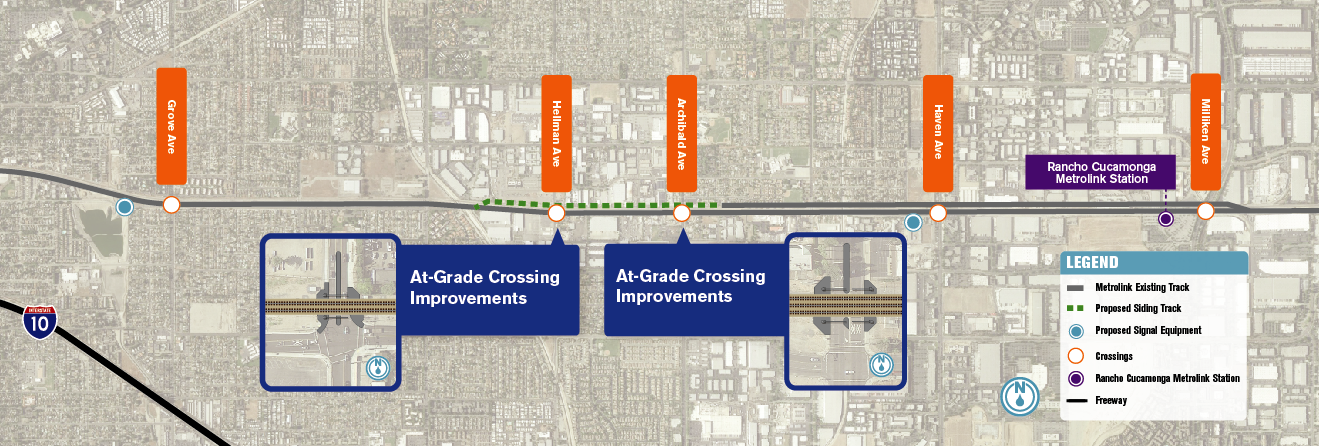
RANCHO CUCAMONGA SIDING EXTENSION PROJECT:
SAN BERNARDINO LINE
The Southern California Regional Rail Authority (Metrolink) has plans to upgrade its regional passenger rail service on the San Bernardino Line through the Rancho Cucamonga Siding Extension Project (Project). The Project is a part of the Southern California Optimized Rail Expansion (SCORE) capital plan to upgrade the Metrolink system in preparation for the Los Angeles 2028 Summer Olympic and Paralympic Games and beyond.
The Project will be constructed almost entirely within Metrolink’s right-of-way, west of the existing Rancho Cucamonga Station and includes:
- Safety-related improvements at two at-grade crossings at Hellman Avenue and Archibald Avenue.
- An extended siding track that will allow trains to pass one another in opposite directions on separate tracks. At Hellman Avenue, the current single-track crossing will be upgraded to a double-track crossing, and at Archibald Avenue, the double-track crossing will be constructed as a triple-track crossing.
Project Map

Project Timeline

CHECK OUT THE BENEFITS:
![]()
More service: when combined with other SCORE projects, this Project will enable more frequent service. In the future, passengers can expect train service every 30 minutes in each direction.
![]()
Improved service reliability: trains will no longer have to wait for one another to pass, improving on-time performance.
![]()
Enhanced safety: improved at-grade crossings will facilitate Quiet Zone ready corridors that will also minimize train horn blowing.
Frequently Asked Questions
The Proposed Rancho Cucamonga Siding Extension (Project) will enhance safety, improve on-time performance, and enable more frequent service. The Project will extend the existing siding track north of the main track 4,600 feet, increasing the total track siding length to 15,600 feet. The Project includes two at-grade crossing improvements at Hellman Avenue and Archibald Avenue, a newly relocated control point on the western end of the extended track siding with associated signal work, and culvert extensions. At Hellman Avenue, the single-track crossing will be upgraded to a double-track crossing and at Archibald Avenue, the double-track crossing will be constructed as a triple-track crossing.
Quiet Zones ease noise in the community by limiting where and when trains are required to blow their horns. A city is responsible to apply for Quiet Zones, which are a Federal designation, once at-grade improvements are made. Metrolink is proposing to build the safety improvements necessary to make two crossings Quiet Zone ready.
The Project improvements will allow Metrolink to provide passengers more reliable and safer service. In the future, passengers would have a train option every 30 minutes in each direction. Commute times for passengers will be reduced with the increased speed and fluid operations. At-grade crossing improvements will also allow riders to cross the tracks more safely.
The Rancho Cucamonga Siding Extension Project would generate jobs and business opportunities, provide environmental benefits, and increase the frequency and the reliability of Metrolink service. San Bernardino County would see reduced traffic congestion and emissions on adjacent freeways which would also result in fewer accidents, reduced emissions and air pollution, and decreased energy consumption. Safety upgrades to current design standards will facilitate Quiet Zone ready corridors in conjunction with the City and minimize train horn blowing.
The Los Angeles Economic Development Corporation (LAEDC) was commissioned to produce a study to assess the impact of the construction investment of the SCORE program. The benefits from SCORE would make the region increasingly attractive for the millions projected to visit SoCal in 2028 and create regional prosperity in the decades to come. San Bernardino County residents could see 6,700 new jobs and $1.732 million in gross regional product by 2028. By 2050, there would be 62,200 new jobs and $67 billion in economic activity.
Roundtable Videos
Rancho Cucamonga Siding Extension, Roundtable Video - English
Rancho Cucamonga Siding Extension, Roundtable Video - Español
Presentation
Project Presentation - English
Fact Sheet
Metrolink SCORE Rancho Cucamonga Siding Fact Sheet – English
